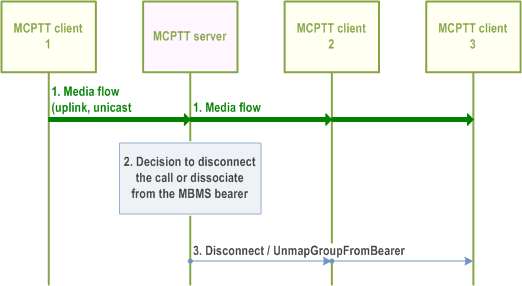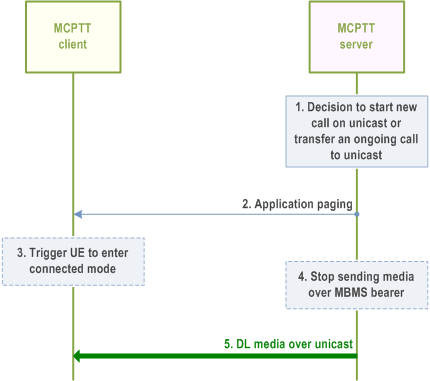Content for TS 23.379 Word version: 19.4.0
1…
7…
10…
10.5…
10.6…
10.6.2.3…
10.6.2.4…
10.6.2.5…
10.6.2.6…
10.6.2.9…
10.6.3…
10.7…
10.7.3…
10.7.5…
10.7.6…
10.9…
10.9.1.3.3…
10.9.1.4…
10.9.2…
10.10…
10.12…
10.19…
10.19.3…
10.19.3.1.4…
10.19.3.2…
10.19.3.2.4…
10.19.3.2.6…
A…
10.10 Use of MBMS transmission (on-network)
10.10.1 Information flows for MBMS Transmission
10.10.2 Use of pre-established MBMS bearers
10.10.3 Use of dynamic MBMS bearer establishment
10.10.4 Call connect and disconnect over MBMS
10.10.5 Switching from MBMS bearer to unicast bearer
10.10.6 Enhanced MCPTT group call setup procedure with MBMS bearer
10.11 MCPTT resource management (on-network)
10.11.1 General
10.11.2 Request for unicast resources at session establishment
10.11.3 Request for modification of unicast resources
10.11.4 Management of multicast media bearers
10.11.5 Request for resources with shared priority
...
...
10.10 Use of MBMS transmission (on-network) p. 199
10.10.1 Information flows for MBMS Transmission p. 199
10.10.1.1 MapGroupToBearer p. 199
Table 10.10.1.1-1 describes the information flow to associate a MCPTT group call to a MBMS bearer. It is sent from the MCPTT server to the MCPTT client.
| Information Element | Status | Description |
|---|---|---|
| MCPTT group ID | M | This element identifies the MCPTT group, in which the call is started |
| Media stream identifier | M | This element identifies the media stream of the SDP used for the group call (e.g. MBMS subchannel) |
| TMGI (see NOTE) | O | The MBMS bearer identifier if the media of the MCPTT group call is not sent on the same MBMS bearer as this MapGroupToBearer message |
| Call acknowledgement indicator | O | Indication that the MCPTT group call requires acknowledgement from receiving MCPTT clients |
|
NOTE:
TMGI shall be present if this message is sent over a different MBMS bearer than the media of the group call; TMGI may be present if this message is sent over the same MBMS bearer as the media of the group call.
|
||
10.10.1.2 UnmapGroupFromBearer p. 200
Table 10.10.1.2-1 describes the information flow to disconnect a MCPTT group call from a MBMS bearer. It is sent from the MCPTT server to the MCPTT client.
| Information Element | Status | Description |
|---|---|---|
| MCPTT group ID | M | This element identifies the MCPTT group which will no longer use the MBMS bearer |
10.10.1.3 Application paging p. 200
Table 10.10.1.3-1 describes the information flow application paging from the MCPTT server to the MCPTT clients.
| Information Element | Status | Description |
|---|---|---|
| MCPTT Group ID (see NOTE) | O | This element identifies the MCPTT group which is paged by the application |
| MCPTT ID (see NOTE) | O | Identity of the MCPTT user which is paged by the application for the private call |
| Cause | M | The cause for this message being sent (e.g. for the use in group calls or private calls) |
|
NOTE:
Either MCPTT Group ID or MCPTT ID is present.
|
||
10.10.2 Use of pre-established MBMS bearers p. 200
The MCPTT service shall support the procedure for using pre-established MBMS bearers as specified TS 23.280. The MCPTT service shall use the MCPTT-1, MCPTT-6, MCPTT-8 and MCPTT-9 reference points for this procedure.
MCPTT may use pre-established MBMS bearer for the different types of MCPTT group calls. Both pre-arranged group calls and chat group calls can use the pre-established MBMS bearer for distributing the media. The MBMS bearer can be used by any group. Depending on the capacity of the MBMS bearer, the bearer can be used to broadcast one or more group calls in parallel.
Both the media packets as well as the floor control messages to the receiving users are sent on the MBMS bearer. Optionally a separate MBMS bearer could be used for the floor control messages, due to different bearer characteristic requirements.
When using the pre-established procedure for MCPTT, the MCPTT server perform the procedure of call connect and disconnect over MBMS as defined in subclause 10.10.4 at the group communication session establishment step.
10.10.3 Use of dynamic MBMS bearer establishment p. 200
The MCPTT service shall support the procedure for using dynamic MBMS bearers as specified TS 23.280. The MCPTT service shall use the MCPTT-1, MCPTT-4, MCPTT-6, MCPTT-7, MCPTT-8 and MCPTT-9 reference points for this procedure.
MCPTT may use dynamic MBMS bearer establishment for the different types of MCPTT group calls. Both pre-arranged group calls and chat group calls can use the dynamic MBMS bearer for distributing the media.
Both the media packets as well as the floor control messages to the receiving users are sent on the MBMS bearer.
When using the procedures for dynamic MBMS bearer establishment for MCPTT, the MCPTT server perform the procedure of call connect and disconnect over MBMS as defined in subclause 10.10.4 at the group communication session establishment step.
10.10.4 Call connect and disconnect over MBMS p. 201
10.10.4.1 General p. 201
MBMS bearer can be used for MCPTT group calls. One MBMS bearer is not permanently associated to one specific group or group call. Before sending media packets of a group call over MBMS bearer, the MCPTT server shall send the association information between group call and the MBMS bearer. The group call setup procedure indicates the media stream within one MBMS bearer that is used for the specific group call. When the group call over the MBMS bearer is finished, this temporary association information of an MCPTT group call to specific resources on a MBMS bearer is undone. The procedure in Figure 10.10.4.2.1-1 requires that the group session is setup before the call start. This eliminates the need for the receiving clients to continuously use a unicast bearer. Prior to this the MBMS bearer is activated and announced to the MCPTT clients.
10.10.4.2 Procedure p. 201
10.10.4.2.1 Call connect over MBMS p. 201
In Figure 10.10.4.2.1-1 the MCPTT client 1 is the client that initiate an MCPTT chat group call and also the transmitting client. MCPTT client 1 may, but does not have to, be in an MBMS service area. The MCPTT client 2 and MCPTT client 3 represents MCPTT clients receiving the MCPTT call over an MBMS bearer. There may be other receiving clients both over unicast bearers and over this or other MBMS bearer(s), however they are not illustrated in this Figure.
The same procedure as for chat group call can also be applied for pre-arranged calls. However, that requires that the pre-arranged sessions are already active. If a pre-arranged group session is initiated the use of pre-established sessions are required.
Pre-conditions:
- All users participating in the MCPTT group call are already affiliated to the group.
- All participating users have joined the group session.

Step 1.
Activation and announcement of MBMS bearer availability.
Step 2.
MCPTT client 1 initiate the MCPTT group call by sending an initial floor request over a unicast bearer to the MCPTT server (reference point MCPTT-4).
Step 3.
The MCPTT server will send a MapGroupToBearer message over a previously activated MBMS bearer to all users that will receive the call over an MBMS bearer. The MapGroupToBearer message includes association information between the group call and MBMS bearer. The MapGroupToBearer message includes MCPTT group ID and information about the media stream identifier of the activated MBMS bearer and may include the identifier (i.e. the TMGI) of the MBMS bearer broadcasting the call. The message is sent over reference point MCPTT-9.
Step 4.
The MCPTT server grants the right to transmit for MCPTT client 1 and by that sends a floor granted message to the MCPTT client 1. This message is sent over a unicast bearer (reference point MCPTT-4).
Step 5.
A floor taken message is sent from the MCPTT server to all receiving users. This message includes the MCPTT ID of the transmitting MCPTT client as well as the MCPTT group ID. The message is sent over a MBMS bearer to all users that have previously been setup to receive calls over the MBMS bearer. The message is sent over reference point MCPTT-9.
Step 6.
The media is sent from MCPTT client 1 to the MCPTT server over unicast bearer and from the MCPTT server to the MCPTT client 2 and MCPTT client 3 over MBMS bearer.
10.10.4.2.2 Call disconnect over MBMS p. 202
Figure 10.10.4.2.2-1 shows the high level procedure where an UnmapGroupFromBearer message is sent by the MCPTT server to the MCPTT clients to indicate that the MCPTT group call is being dissociated from the MBMS bearer.

Step 1.
An MCPTT group call is ongoing; the media is broadcasted over MBMS bearer to MCPTT client 2 and MCPTT client 3.
Step 2.
MCPTT server has determined to disconnect the call over the MBMS bearer for the MCPTT clients
Step 3.
An UnmapGroupFromBearer message is sent by the MCPTT server to MCPTT client 2, MCPTT client 3 and possibly to MCPTT client 1 (if in MBMS coverage area) on MBMS bearer(s).
10.10.5 Switching from MBMS bearer to unicast bearer p. 203
The MCPTT service shall support the procedure for switching from MBMS bearer to unicast bearer as specified TS 23.280. The MCPTT service shall use the MCPTT-1, MCPTT-4, MCPTT-7, MCPTT-8 and MCPTT-9 reference points for this procedure.
10.10.6 Enhanced MCPTT group call setup procedure with MBMS bearer p. 203
10.10.6.1 Description p. 203
When the MCPTT server initiates a new MCPTT call, the MCPTT server shall decide to use unicast bearers or broadcast bearers for the downlink media. A similar decision may also be made for other types of media communication e.g. MCVideo. To decide to use broadcast or unicast involves a number of aspects. The Figure 10.10.6.1-1 specifies a procedural flow to perform such decision.
The flow described evaluates which bearer type to use for a new MCPTT group call. It is assumed that if an MBMS bearer is active it is also announced to the MCPTT client.
When using an MBMS bearer for application level control signalling, the announcement of an already active MBMS bearer could be part of the MCPTT group call setup, however that will have an impact on the call setup time.

On a high level the procedure outcome is to use unicast or broadcast bearers for the new MCPTT group call. For an enhanced group call setup procedure, the MBMS bearer may be used to trigger the use of a unicast bearer.
10.10.6.2 Procedure p. 204
The procedure in Figure 10.10.6.2-1 can be used in the following scenarios:
- Initiate a new call on unicast bearer
- Transfer an ongoing call from broadcast bearer to unicast bearers
- There must be an active and announced MBMS bearer

Step 1.
Step 4-5 may be performed in parallel with step 2-3. Step 5 will trigger a normal paging in EPC and RAN if the client is still in idle mode.
The MCPTT server initiates a new MCPTT group call on unicast or decides to transfer an ongoing call to unicast, or may initiate an MCPTT private call.
Step 2.
The MCPTT sends an application paging message on the MBMS bearer to inform the MCPTT client that the MCPTT server will initiate media transmission over a unicast bearer.
Step 3.
In the case that the UE is in idle mode the UE will initiate a service request to transfer the UE to connected mode.
Step 4.
The MCPTT server stops sending the media over an MBMS bearer. This step is only performed if transferring an ongoing call.
Step 5.
The MCPTT server initiates the media transmission over the unicast bearer.
10.11 MCPTT resource management (on-network) p. 205
10.11.1 General p. 205
Procedures for resource management are defined in subclause 10.11 of TS 23.280.
10.11.2 Request for unicast resources at session establishment p. 205
Void
10.11.3 Request for modification of unicast resources p. 205
Void
10.11.4 Management of multicast media bearers p. 205
Void